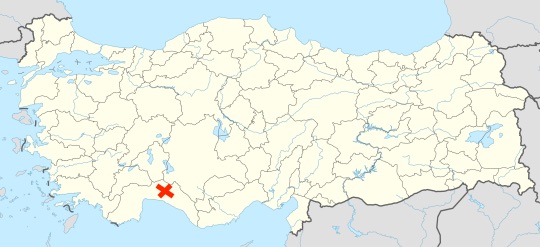 Triskeles, a symbol of Aspendos,
Triskeles, a symbol of Aspendos, an ancient city in Pamphylia
 Triskeles, a symbol of Aspendos,
Triskeles, a symbol of Aspendos,
an ancient city in Pamphylia
A symbol with three human legs radiating at equal angles from a common center is called a triskeles ("three-legs"). The first type from the city of Aspendos (a.k.a. Aspendus, located at the red X, 8 miles inland on a river) has a helmeted hoplite warrior with spear and shield on the obverse and a triskeles on the reverse with a few Greek letters abbreviating the name of the city in the Pamphylian dialect.
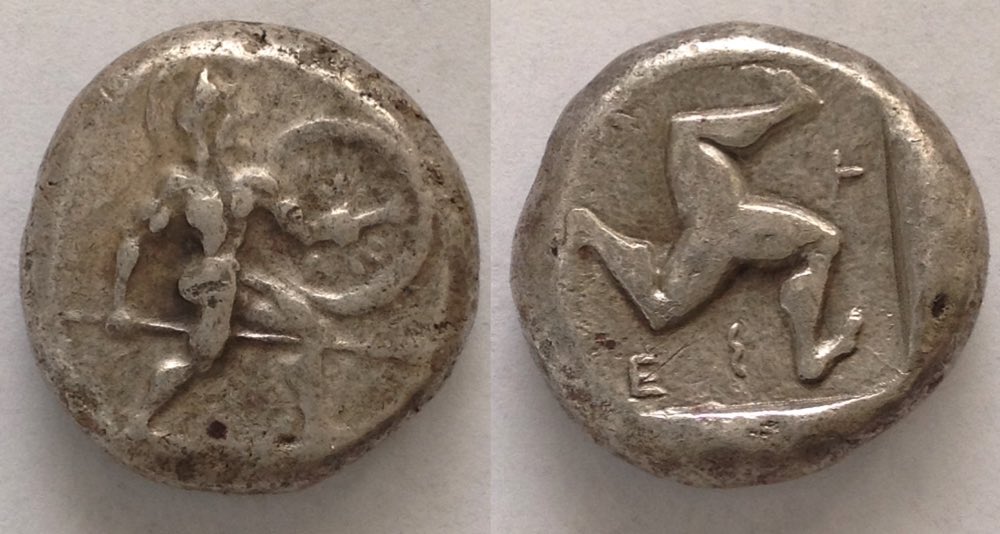
Aspendos. Stater. 19 mm. 10.72 grams. Thick.
c. 465-430 BC.
Hoplite warrior right, helmeted with spear and shield.
In incuse square triskeles (running right) EΣ-T below and to right,
which abbreviates in Greek the city name in the Pamphylian language--ESTEFΔIIYI (for "Estwediiys") see the next coin and the type with the slinger and wrestlers).
SNG France 3 Pamphylie #6 (#1-11 are very similar but with various positions of the letters and some with the triskeles running left).
Sear Greek 5381.
The next type is similar but has a lion through the legs. The triskeles-alone type is thick, as archaic coins often are, with smaller diameter than the type with a lion, which indicates the triskeles-alone type is the earlier type. The triskeles-with-lion type is cataloged with the same date range as the type above, but listed after that type, indicating the above type is the first type and the next type with the lion is the second type.
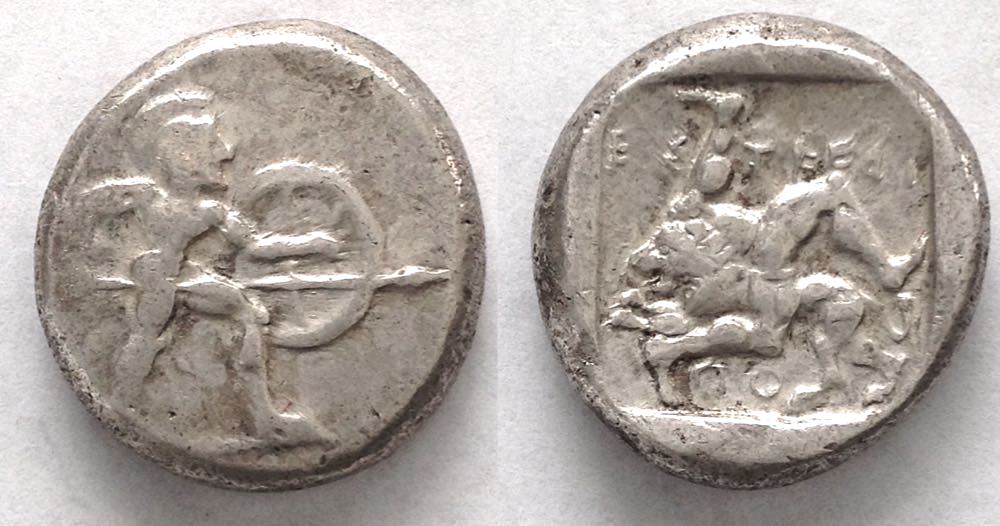 Aspendos. Stater. 21-20 mm. 10.94 grams.
Aspendos. Stater. 21-20 mm. 10.94 grams.
Struck c. 465-430 [according to SNG France 3].
Hoplite warrior right, helmeted with spear and shield
triskeles, with lion left through it, turtle in upper right, in incuse square.
EΣ-TFEΛI above, abbreviating the city name, ΠO below.
SNG France 3, 12-13 are similar, but with fewer letters and each has a test cut on the triskeles side.
Sear Greek 5383v (It has the lion right instead of left).
Note for collectors: Both types are expensive in Sear's Greek Coins and Their Values. They are listed at 750 pounds and 1,250 pounds in VF. The coins above are from a hoard which appeared on the market c. 2018 and which is still being disbursed (as of September 2019). Prior to the hoard the lion-in-triskeles type was much rarer than the triskeles-alone type. Here are the numbers from major published collections.
| Collection | triskeles alone |
triskeles with lion |
wrestlers |
| SNG Danish | 27 | 0 | 67 |
| SNG von Aulock | 7 | 1 | 77 |
| SNG France 3 | 11 | 2 | 82 |
| BMC Pamphylia | 8 | 1 | 55 |
| Weber | 2 | 0 | 8 |
| McClean | 0 | 0 | 5 |
The numbers in the table include many variants. The number of abbreviating letters varies and their positions vary. Sometimes the warrior has a sword instead of spear. Sometimes adjuncts like turtles or clubs are in the fields. The lion can be facing left or right. The wrestlers have numerous poses and control marks.
In the above collections the illustrated examples of the first two types are not in excellent condition and only a few match or excel the coins illustrated above. Almost all pieces have weak strikes with some flattening or small flans or other serious detractions. Many have test cuts. Even the best examples are not well-struck and high grade.
I have some examples for sale here: http://augustuscoins.com/Greek.html
I am not privy to the details of the hoard, but recent auctions suggest it had many pieces with the lion type and even more pieces without the lion. However, it appears to confirm that examples in excellent condition are extremely rare, if any exist. For example, the firm Roma Numismatics which usually offers coins in the highest grades offered these two in their auction XVI in 2018:
Lot 317 hammered at 2400 pounds + 20% in spite of having flat spots on the obverse and blurring on the reverse:
https://www.romanumismatics.com/189-lot-317-pamphylia-aspendos-ar-stater?auction_id=46&view=lot_detail
Lot 318 hammered at 800 pounds + 20%:
https://www.romanumismatics.com/189-lot-318-pamphylia-aspendos-ar-stater?auction_id=46&view=lot_detail
Auction 17 (March 2019), lot 521 is one of the best and not from the recent hoard. It hammered at 6000 pounds plus 20%:
https://www.romanumismatics.com/208-lot-521-pamphylia-aspendos-ar-stater-?auction_id=62&view=lot_detail
In Sear the image of the first type is much worse than the first example above and his image of the second type is of the BMC piece which is slightly sharper. None of the examples of the first type in SNG Danish or SNG France or the BMC are better than this one. Perhaps that explains why a full European "VF" piece is listed in Sear as so valuable. Hardly any exist.
Each type comes with numerous variants. For example, the next coin has fewer letters and a turtle in the fields.
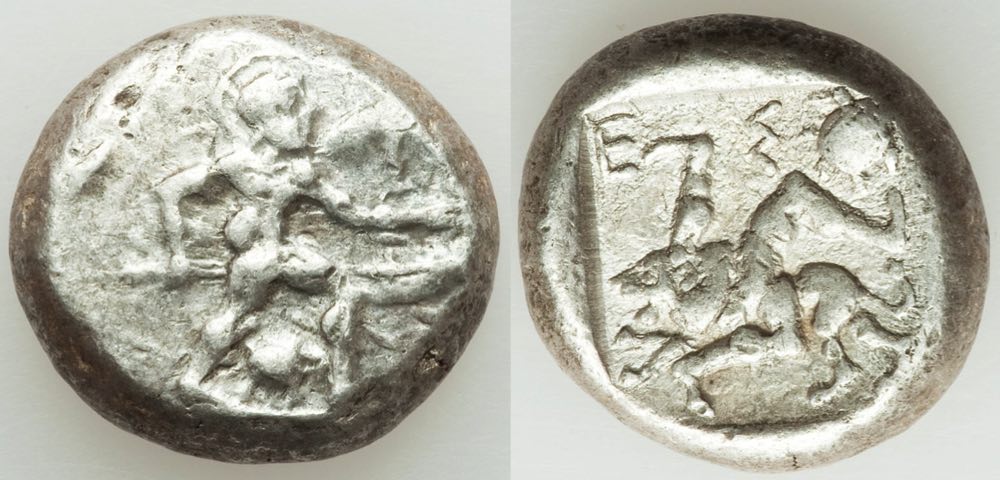
Aspendos. Stater. 21 mm. 10.90 grams.
Struck c. 465-430 [according to SNG France 3].
Hoplite warrior right, helmeted with spear and shield,
turtle between legs.
Triskeles, with lion left through it, turtle in upper right, in incuse square.
EΣ above, abbreviating the city name.
SNG France 3, 12-13 are similar but without the turtles (each has a test cut on the triskeles side).
Sear Greek 5383v (It has the lion right instead of left).
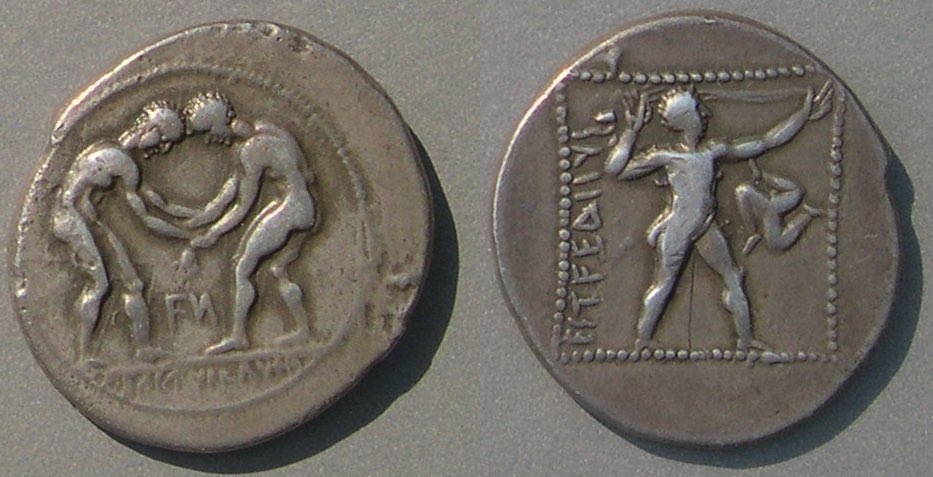 Aspendos.
Aspendos.
24 mm. 10.72 grams. Stater. Broader and thinner than the above earlier types.
370-330 BC.
Two naked athletes, wrestling. FN [N retrograde] between. MENETYΣEΛΦA in exergue on this die (but not on most) naming the two wrestlers, presumably famous at the time.
Slinger right in square border of dots, with ESTEFΔIIY up to the right, Triskeles in right field.
SNG von Aulock (volume 2) 4502-4578 are "wrestlers/slinger" types. 4568 has the same obverse die, and 4569 has both dies the same.
SNG Danish Pamphylia (volume 6) 197-245 are similar, but none have a legend below the slinger.
Sear Greek 5390v.
The city of Selge, 30 miles north of Aspendos, further inland, did not issue coins until the fourth century. When they began coining, the type copied the coins of Aspendos.
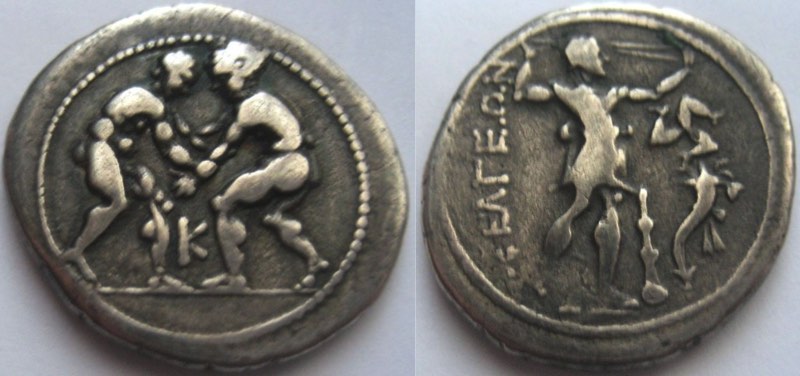 Selge, Pisidia.
Selge, Pisidia. if you are aware of references that address any reasons for using a triskeles. I want to know and can easily change this page to include them.)
if you are aware of references that address any reasons for using a triskeles. I want to know and can easily change this page to include them.) L. Cornelius Lentulus and C. Claudius Marcellus,
L. Cornelius Lentulus and C. Claudius Marcellus,
Struck at a military mint in the East, 49 BC.
20-18 mm. 3.94 grams. Denarius.
Triskeles, with head of Medusa at the center and ears of wheat between the legs.
Jupiter standing left, holding thunderbolt and eagle,
LEN MR COS upwards in fields
Crawford 445/1b. Sear 414.
Crawford [p. 738] writes "The triskeles is the family type of the Marcelli." An ancestor, M. Claudius Marcellus, captured Syracuse in Sicily in 211 BC during the second Punic War.
The trikskeles is still used as a symbol of Sicily. Here is a modern lead seal from Palermo, Sicily, with a triskeles:
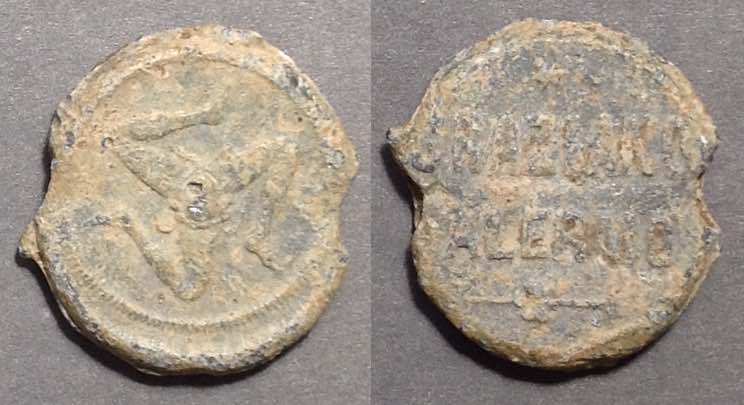
Lead. 19-17 mm.
Triskeles
GRAZIANO
PALERMO
Other Ancient Triskeles. A triskeles was used in Lycia (neighboring, and just west of Pamphylia) under the Persian dynasts before Alexander the Great. On Lycian coins the three "legs" are not human legs, but merely curved projections from a circle.
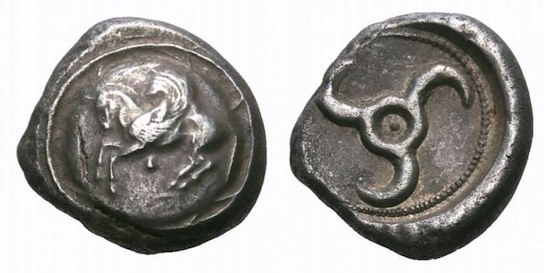 Lycian, uncertain dynast,
Lycian, uncertain dynast,
c. 480/470-430 BC.
20-19 mm. 9.80 grams. Stater.
Pegasus left.
Triskeles in round incuse.
The dynast is uncertian because there are no identifying letters between the legs. In contrast, the next coins have identifying letters.
SNG von Aulock 4089 "uncertain dynast, c. 500-440 BC."
BMC Lycia 122 "c. 405-305."
Sear Greek -- (would be after 5178).
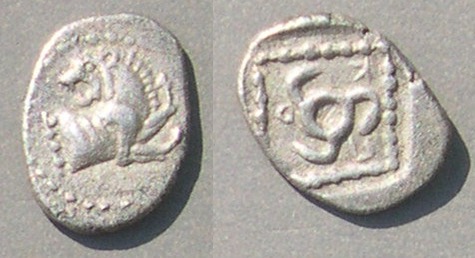 Lycian dynast, Kuprlli. c. 470-440 BC.
Lycian dynast, Kuprlli. c. 470-440 BC.
13-10 mm. 1.17 grams. Diobol.
Forepart of lion right, looking back.
Triskeles with letters around.
Similar to SNG von Aulock 8479 which is a tetraobol.
Sear Greek -- (would be after 5204).
BMC Lycia --, 64 is similar but their lion is winged.
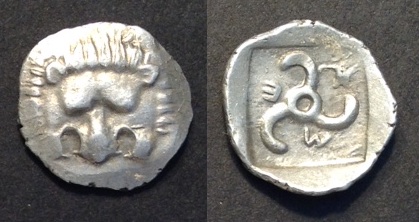
Lycian dynast Mithrapata, c. 380 BC.
15-13 mm. 1.14 grams. Diobol.
Lion's scalp.
Triskeles with letters around.
SNG Danish supplement Lycia 476 "a sixth stater, c. 480-1st half of 4th C. BC."
SNG von Aulock -- (nothing close).
Sear Greek 5228.
SNG Turkey I Kayhan --.
The connection with the number three is not so certain on Lycian coins. Here is a similar device with four legs.
 Lycian Dynast Teththiweibi,
Lycian Dynast Teththiweibi,
450-425 BC of Antiphellus(?).
19-17 mm. 8.92 grams. Stater.
Head of goddess (Aphrodite?) left.
Quadskeles with four legs.
BMC Lycia 91 "c. 480-469 BC."
Sear Greek 5207.
Conclusion. The first two types of Aspendos are silver staters with a large triskeles of human legs. They have recently become more common with the disbursal of a hoard. Formerly, the vast majority of coins offered of Aspendos were of the famous and popular "wrestlers-and-slinger" type which often has a small triskeles in the field. The triskeles is a symbol of Aspendos but the reason for using it is obscure.
I have some examples for sale here: http://augustuscoins.com/Greek.html
References:
Sear, David. Greek Coins and Their Values, volume II, Asia and North Africa, 1979. Hardcover.
Sylloge Nummorum Graecorum France 3, Pamphylia, Pisidie, Lyconie, Galatie. Bibliotheque Nationale de France. 1994. Hardcover.
Grainger, John D. The Cities of Pamphylia. 2009. Cardcover.
BMC Greek Lycia, Pamphylia, and Pisidia. 1897, by George Francis Hill.
SNG von Aulock (reprint volume 2) plate 146.
SNG Danish [a.k.a. Copenhagen] (reprint volume 6)
Head, Barklay. Historia Numorum, A Manual of Greek Numismatics. 1911.
Kraay, Colin. Archaic and Classical Greek Coins. 1976. Especially pages 276-7.
wikipedia calls this design a "triskelion," but numismatists do not.
Go to the Table of Contents for this entire educational site.